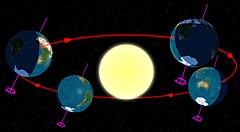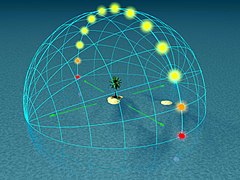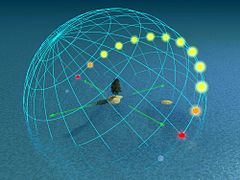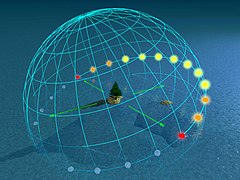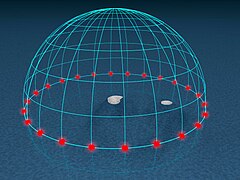Equinox
From Wikipedia, the free encyclopedia
| This article needs additional citations for verification. Please help improve this article by adding reliable references (ideally, using inline citations). Unsourced material may be challenged and removed. (November 2008) |
| UTC date and time of solstices and equinoxes[1] | ||||||||
|---|---|---|---|---|---|---|---|---|
| year | Equinox Mar |
Solstice June |
Equinox Sept |
Solstice Dec |
||||
| day | time | day | time | day | time | day | time | |
| 2004 | 20 | 06:49 | 21 | 00:57 | 22 | 16:30 | 21 | 12:42 |
| 2005 | 20 | 12:33 | 21 | 06:46 | 22 | 22:23 | 21 | 18:35 |
| 2006 | 20 | 18:26 | 21 | 12:26 | 23 | 04:03 | 22 | 00:22 |
| 2007 | 21 | 00:07 | 21 | 18:06 | 23 | 09:51 | 22 | 06:08 |
| 2008 | 20 | 05:48 | 20 | 23:59 | 22 | 15:44 | 21 | 12:04 |
| 2009 | 20 | 11:44 | 21 | 05:45 | 22 | 21:18 | 21 | 17:47 |
| 2010 | 20 | 17:32 | 21 | 11:28 | 23 | 03:09 | 21 | 23:38 |
| 2011 | 20 | 23:21 | 21 | 17:16 | 23 | 09:04 | 22 | 05:30 |
| 2012 | 20 | 05:14 | 20 | 23:09 | 22 | 14:49 | 21 | 11:11 |
| 2013 | 20 | 11:02 | 21 | 05:04 | 22 | 20:44 | 21 | 17:11 |
| 2014 | 20 | 16:57 | 21 | 10:51 | 23 | 02:29 | 21 | 23:03 |
| 2015 | 20 | 22:45 | 21 | 16:38 | 23 | 08:20 | 22 | 04:48 |
| 2016 | 20 | 04:30 | 20 | 22:34 | 22 | 14:21 | 21 | 10:44 |
| 2017 | 20 | 10:28 | 21 | 04:24 | 22 | 20:02 | 21 | 16:28 |
An equinox occurs twice a year, when the tilt of the Earth's axis is inclined neither away from nor towards the Sun, the Sun being vertically above a point on the Equator. The term equinox can also be used in a broader sense, meaning the date when such a passage happens.
The name "equinox" is derived from the Latin aequus (equal) and nox (night), because around the equinox, the night and day are approximately equally long. It may be better understood to mean that latitudes +L and -L north and south of the equator experience nights of equal length.
The word is also used for the same event happening on other planets and in setting up a celestial coordinate system; see equinox (celestial coordinates).
At an equinox, the Sun is at one of two opposite points on the celestial sphere where the celestial equator (i.e. declination 0) and ecliptic intersect. These points of intersection are called equinoctial points: the vernal point and the autumnal point. By extension, the term equinox may denote an equinoctial point.
An equinox happens each year at two specific moments in time (rather than two whole days), when there is a location on the Earth's Equator where the centre of the Sun can be observed to be vertically overhead, occurring around March 20/21 and September 22/23 each year.
Contents |
[edit] Names
- Vernal equinox and autumnal equinox: these classical names are direct derivatives of Latin (ver = spring and autumnus = autumn).
- March equinox and September equinox: a usage becoming the preferred standard by technical writers choosing to avoid Northern Hemisphere bias (implied by assuming that March is in the springtime and September is autumnal—true for those in the Northern Hemisphere but quite the opposite for the Southern Hemisphere).
- Northward equinox and southward equinox: names referring to the apparent motion of the Sun at the times of the equinox.
- Vernal point and autumnal point are the points on the celestial sphere where the Sun is located on the vernal equinox and autumnal equinox respectively (again, the seasonal attribution is that of the Northern Hemisphere).
- First point (or cusp) of Aries or Libra are archaic names used by navigators and astrologers. Navigational ephemerus tables record the geographic position of the First Point of Aries as the reference for position of navigational stars. Due to the precession of the equinoxes, the astrological signs where these equinoxes are located no longer correspond with the actual constellations once ascribed to them.
[edit] Length of equinoctial day and night
On a day of an equinox, the centre of the Sun spends a roughly equal amount of time above and below the horizon at every location on the Earth, night and day being of roughly the same length. The word equinox derives from the Latin words aequus (equal) and nox (night); in reality, the day is longer than the night at an equinox. Commonly, the day is defined as the period when sunlight reaches the ground in the absence of local obstacles. From the Earth, the Sun appears as a disc rather than a single point of light, so when the centre of the Sun is below the horizon, its upper edge is visible. Furthermore, the atmosphere refracts light, so even when the upper limb of the Sun is below the horizon, its rays reach over the horizon to the ground. In sunrise/sunset tables, the assumed semidiameter (apparent radius) of the Sun is 16 minutes of arc and the atmospheric refraction is assumed to be 34 minutes of arc. Their combination means that when the upper limb of Sun is on the visible horizon, its centre is 50 minutes of arc below the geometric horizon, which is the intersection with the celestial sphere of a horizontal plane through the eye of the observer. These cumulative effects make the day about 14 minutes longer than the night at the Equator and longer still towards the Poles. The real equality of day and night only happens in places far enough from the equator to have a seasonal difference in day length of at least 7 minutes, actually occurring a few days towards the winter side of each equinox.
The date at which the time between sunset and sunrise crosses 12 hours , is known as the equilux. Because sunset and sunrise times vary with an observer's geographic location (longitude and latitude), the equilux likewise depends on location and does not exist for locations sufficiently close to the equator. The equinox, however, is a precise moment in time which is common to all observers on Earth.
[edit] Heliocentric view of the seasons
The Earth's seasons are caused by the rotation axis of the Earth not being perpendicular to its orbital plane. The Earth's axis is tilted at an angle of approximately 23.44° from the orbital plane; this tilt is called the axial tilt. As a consequence, for half of the year (i.e. from around March 20 to around September 22), the northern hemisphere tips toward the Sun, with the maximum around June 21, while for the other half of the year, the southern hemisphere has this honour, with the maximum around December 21. The two instants when the Sun is directly overhead at the Equator are the equinoxes. Also at that moment, both the North and South Poles of the Earth are just on the terminator and day and night are divided equally between the hemispheres.
The table above gives the dates and times of equinoxes and solstices over several years. A few remarks can be made about the equinoxes:
- Because the Sun is a spherical (rather than a single-point) source of light, the actual crossing of the Sun over the Equator takes approximately 33 hours.
- At the equinoxes, the rate of change for the length of daylight and night-time is the greatest. At the Poles, the equinox marks the start of the transition from 24 hours of nighttime to 24 hours of daylight. High in the Arctic Circle, Longyearbyen, Svalbard, Norway has an additional 15 minutes more daylight every day around the time of the Spring equinox, whereas in Singapore (which is virtually on the Equator), the amount of daylight each day varies by just seconds.
- It is 94 days from the June solstice to the September equinox, but only 89 days from the December Solstice to the March equinox. The seasons are not of equal length, because of the variable speed of the Earth in its orbit around the Sun.
- The instances of the equinoxes are not fixed, but fall about six hours later every year, amounting to one full day in four years. They are reset by the occurrence of a leap year. The Gregorian calendar is designed to follow the seasons as accurately as is practical, which is good, but not absolutely perfect. Also see: Gregorian calendar#Calendar seasonal error.
- Smaller irregularities in the times are caused by perturbances of the Moon and the other planets.
- Currently, the most common equinox and solstice dates are March 20, June 21, September 22 and December 21; the four-year average will slowly shift to earlier times in coming years. This shift is a full day in about 70 years (compensated mainly by the century "leap year" rules of the Gregorian calendar). This also means that in many years of the twentieth century, the dates of March 21, June 22, September 23 and December 22 were much more common, so older books teach (and older people may still remember) these dates.
- Note that the times are given in UTC (roughly speaking, the time at Greenwich, ignoring British Summer Time). People living farther to the east (Asia and Australia), whose local times are in advance, will see the seasons apparently start later; for example, in Tonga (UTC+13), an equinox occurred on September 24, 1999, a date which will not crop up again until 2103. On the other hand, people living far to the west (America) whose clocks run behind UTC may experience an equinox as early as March 19.
[edit] Geocentric view of the seasons
In the half year centred on the June solstice, the Sun rises and sets towards the north, which means longer days with shorter nights for the Northern Hemisphere and shorter days with longer nights for the Southern Hemisphere. In the half year centred on the December solstice, the Sun rises and sets towards the south and the durations of day and night are reversed.
Also on the day of an equinox, the Sun rises everywhere on Earth (except the Poles) at 06:00 in the morning and sets at 18:00 in the evening (local time). These times are not exact for several reasons, one being that the Sun is much larger in diameter than the Earth that more than half of the Earth could be in sunlight at any one time (due to unpaparallel rays creating tangent points beyond an equal-day-night line); other reasons are as follows:
- Most places on Earth use a time zone which is unequal to the local time, differing by up to an hour or even two hours, if daylight saving time (summer time) is included. In that case, the Sun could rise at 08:00 and set at 20:00, but there would still be 12 hours of daylight.
- Even those people fortunate enough to have their time zone equal to the local time will not see sunrise and sunset at 06:00 and 18:00 respectively. This is due to the variable speed of the Earth in its orbit, and is described as the equation of time. It has different values for the March and September equinoxes (+8 and −8 minutes respectively).
- Sunrise and sunset are commonly defined for the upper limb of the solar disk, rather than its centre. The upper limb is already up for at least one minute before the centre appears, and likewise, the upper limb sets one minute later than the centre of the solar disk. Due to atmospheric refraction, the Sun, when near the horizon, appears a little more than its own diameter above the position than where it is in reality. This makes sunrise more than another two minutes earlier and sunset the equal amount later. These two effects add up to almost seven minutes, making the equinox day 12hrs 7min long and the night only 11hrs 53min. In addition to that, the night includes twilight. When dawn and dusk are added to the daytime instead, the day would be almost 13 hours.
- The above numbers are only true for the tropics. For moderate latitudes, this discrepancy increases (for example, 12 minutes in London) and closer to the Poles it gets very large. Up to about 100 km from both Poles, the Sun is up for a full 24 hours on an equinox day.
- Height of the horizon on both the sunrise and sunset sides changes the day's length. Going up into the mountains will lengthen the day, while standing in a valley with hilltops on the east and the west can shorten the day significantly. This is why settlements in east-west running valleys are more favourable (daylight-wise) than north-south running valleys.
[edit] Day arcs of the Sun
Some of the above statements can be made clearer when picturing the day arc (i.e. the path the Sun tracks along the celestial dome in its diurnal movement). The pictures show this for every hour on equinox day. In addition, some 'ghost' suns are also indicated below the horizon, up to 18° down. The Sun in this area still causes twilight. The pictures can be used for both Northern and Southern hemispheres. The observer is supposed to sit near the tree on the island in the middle of the ocean; the green arrows give cardinal directions.
- On the northern hemisphere, north is to the left, the Sun rises in the east (far arrow), culminates in the south (right arrow) while moving to the right and setting in the west (near arrow).
- On the southern hemisphere, south is to the left, the Sun rises in the east (near arrow), culminates in the north (right arrow) while moving to the left and setting in the west (far arrow).
The following special cases are depicted:
- The day arc on the Equator, passing through the zenith, has almost no shadows at high noon.
- The day arc on 20° latitude: the Sun culminates at 70° altitude and also its daily path at sunrise and sunset occurs at a steep 70° angle to the horizon. Twilight is still about one hour.
- The day arc on 50° latitude: twilight is almost two hours now.
- The day arc on 70° latitude: the Sun culminates at no more than 20° altitude and its daily path at sunrise and sunset is at a shallow 20° angle to the horizon. Twilight is more than four hours; in fact, there is barely any night.
- The day arc at the Pole: if it were not for atmospheric refraction, the Sun would be on the horizon all the time.
[edit] Celestial co-ordinate systems
The vernal point (vernal equinox) — the one the Sun passes in March on its way from south to north — is used as the origin of some celestial coordinate systems:
- in the ecliptic coordinate system, the vernal point is the origin of the ecliptic longitude;
- in the equatorial coordinate system, the vernal point is the origin of the right ascension.
Because of the precession of the Earth's axis, the position of the vernal point changes over time and as a consequence, both the Equatorial and the ecliptic co-ordinate systems change over time. Therefore, when specifying celestial co-ordinates for an object, one has to specify at what time the vernal point (and also the celestial equatorial) are taken. That reference time is also called equinox.
The autumnal equinox is at ecliptic longitude 180° and at right ascension 12h.
The upper culmination of the vernal point is considered the start of the sidereal day for the observer. The hour angle of the vernal point is, by definition, the observer's sidereal time.
For western tropical astrology, the same thing holds true; the vernal equinox is the first point (i.e. the start) of the sign of Aries. In this system, it is of no significance that the fixed stars and equinox shift compared to each other due to the precession of the equinoxes.
[edit] Cultural aspects of the equinox

- The Persian new year, Nowruz, is held annually on the vernal equinox, as the beginning of spring.
- The September equinox marks the first day of Mehr or Libra in the Persian calendar. It is one of the Iranian festivals called Jashne Mihragan, or the festival of sharing or love in Zoroastrianism.
- Sham El Nessim was an ancient Egyptian holiday which can be traced back as far as 2700 B.C. It is still one of the public holidays in Egypt. Sometime during Egypt's Christian period (c. 200-639) the date moved to Easter Monday, but before then it coincided with the vernal equinox.
- The Jewish Passover usually falls on the first full moon after the Northern Hemisphere vernal equinox, although occasionally (4 or 5 times every 19 years) it will occur on the second full moon.
- The Christian churches calculate Easter as the first Sunday after the first full moon on or after the March equinox. The official church definition for the equinox is March 21; however, as the Eastern Orthodox Churches use the older Julian calendar, while the Western Churches use the Gregorian calendar, both of which designate March 21 as the equinox, the actual date of Easter differs. The earliest possible Easter date in any year is therefore March 22 on each calendar.
- The March equinox marks the first day of various calendars including the Iranian calendar and the Bahá'í calendar.[2] The Persian (Iranian) festival of Nowruz is celebrated then. According to the ancient Persian mythology Jamshid, the mythological king of Persia, ascended to the throne on this day and each year this is commemorated with festivities for two weeks. These festivities recall the story of creation and the ancient cosmology of Iranian and Persian people. It is also a holiday for Azerbaijan, Afghanistan, India, Turkey, Zanzibar, Albania, and various countries of Central Asia, as well as among the Kurds. As well as being a Zoroastrian holiday, it is also a holy day for adherents of the Bahá'í Faith and the Nizari Ismaili Muslims.[3]
- The traditional East Asian calendars divide a year into 24 solar terms (節氣, literally "climatic segments"), and the vernal equinox (Chūnfēn, Chinese and Japanese: 春分; Korean: 춘분; Vietnamese: Xuân phân) and the autumnal equinox (Qiūfēn, Chinese and Japanese: 秋分; Korean: 추분; Vietnamese: Thu phân) mark the middle of the spring and autumn seasons, respectively. In this context, the Chinese character 分 means "(equal) division" (within a season).
- In Japan, (March) Vernal Equinox Day (春分の日 Shunbun no hi) is an official national holiday, and is spent visiting family graves and holding family reunions. Similarly, in September, there is an Autumnal Equinox Day (秋分の日 Shūbun no hi).
- In Korea, Chuseok is a major harvest festival and a three-day holiday celebrated around the Autumn Equinox.
- The Mid-Autumn Festival is celebrated on the 15th day of the 8th lunar month, oftentimes near the autumnal equinox day, and is an official holiday in China and in many countries with a significant Chinese minority. As the lunar calendar is not synchronous with the Gregorian calendar, this date could be anywhere from mid-September to early October.
- Tamil and Bengali New Years follow the Hindu zodiac and are celebrated according to the sidereal vernal equinox (April 14). The former is celebrated in the South Indian state of Tamil Nadu, and the latter in Bangladesh and the East Indian state of West Bengal.
- Andhra Pradesh, Karnataka and Maharastra people celebrate new year ugadi set by Satavahana on the first morning after first new moon from March equinox. Also the calculations of the great Indian Mathematician Bhaskaracharya proclaim the Ugadi day as the beginning of the New Year, New month and New day.
- In many Arab countries, Mother's Day is celebrated on the March equinox.
- The harvest festival in the United Kingdom is celebrated on the Sunday of the full moon closest to the September equinox.
Modern innovations:
- The September equinox was "New Year's Day" in the French Republican Calendar, which was in use from 1793 to 1805. The French First Republic was proclaimed and the French monarchy was abolished on September 21, 1792, making the following day (the equinox day that year) the first day of the "Republican Era" in France. The start of every year was to be determined by astronomical calculation, (that is: following the real Sun and not the mean Sun as all other calendars).
- World Storytelling Day is a global celebration of the art of oral storytelling, celebrated every year on the spring equinox in the northern hemisphere, the first day of autumn equinox in the southern.
- World Citizen Day occurs on the March equinox.[4]
- In Annapolis, Maryland, USA, boatyard employees and sailboat owners celebrate the spring equinox with the Burning Of The Socks festival. Traditionally, the boating community wears socks only during the winter. These are burned at the approach of warmer weather, which brings more customers and work to the area. Officially, nobody then wears socks until the next equinox.[5]
- Kerala, a state of India celebrates the celestial vernal equinox as their New year around April 14. It is known as 'Vishu' meaning equal in Sanskrit.
- Earth Day was initially celebrated on March 21, 1970, the equinox day. It is currently celebrated in various countries on April 22.
- Wiccans and many other Neopagans hold religious celebrations of "Ostara" on the spring equinox, and "Mabon" on the autumnal equinox.
[edit] Myths, fables and facts
| Lists of miscellaneous information should be avoided. Please relocate any relevant information into appropriate sections or articles. (March 2009) |
- One effect of equinoctial periods is the temporary disruption of communications satellites. For all geostationary satellites, there are a few days near the equinox when the sun goes directly behind the satellite relative to Earth (i.e. within the beamwidth of the groundstation antenna) for a short period each day. The Sun's immense power and broad radiation spectrum overload the Earth station's reception circuits with noise and, depending on antenna size and other factors, temporarily disrupt or degrade the circuit. The duration of those effects varies but can range from a few minutes to an hour. (For a given frequency band, a larger antenna has a narrower beamwidth, hence experiences shorter duration "Sun outage" windows).
- A modern folk-notion[clarification needed] claims that on the March equinox day (some may also include the September equinox day rather than leaving it out), one can balance an egg on its point.[6][7] However, one can balance an egg on its point any day of the year...if one has enough patience.[8]
- Although the word equinox is often understood to mean "equal [day and] night," as is noted elsewhere, this is not strictly true. For most locations on earth, there are two distinct identifiable days per year when the length of day and night are closest to being equal; those days are commonly referred to as the "equiluxes" to distinguish them from the equinoxes. Equinoxes are points in time, but equiluxes are days. By convention, equiluxes are the days where sunrise and sunset are closest to being exactly 12 hours apart. This way, you can refer to a single date as being the equilux, when in reality, it spans from sunset on one day to sunset the next, or sunrise on one to sunrise the next.
- What is true about the equinoxes is that two observers at the same distance north and south of the equator will experience nights of equal length.
- The equilux counts times when some direct sunlight could be visible, rather than all hours of usable daylight (which is any time when there is enough natural light to do outdoor activities without needing artificial light). This is due to twilight; a particular type of twilight which is officially defined as civil twilight. This amount of twilight can result in more than 12 hours of usable daylight up to a few weeks before the spring equinox, and up to a few weeks after the fall equinox.
- In a contrary vein, the daylight which is useful for illuminating houses and buildings during the daytime and is needed to produce the full psychological benefit of daylight, is shorter than the nominal time between sunrise and sunset. So in that sense, "useful" daylight is present for 12 hours only after the vernal equinox and before the autumnal equinox, because the intensity of light near sunrise and sunset, even with the sun slightly above the horizon, is considerably less than when the sun is high in the sky.
- It is perhaps valuable for people in the Americas and Asia to know that the equinoxes listed as occurring on March 21, which occurred frequently in the 20th century and which will occur occasionally in the 21st century, are presented as such using UTC, which is at least four hours in advance of any clock in the Americas and as much as twelve hours behind Asian clocks. Thus, there will be no spring equinox later than March 20 in the Americas in the coming century.
[edit] References
- ^ United States Naval Observatory (01/28/07). "Earth's Seasons: Equinoxes, Solstices, Perihelion, and Aphelion, 2000-2020". http://aa.usno.navy.mil/data/docs/EarthSeasons.php.
- ^ Baha'i calendar
- ^ "The Ismaili: Navroz". http://www.theismaili.org/cms/232/Navroz. Retrieved on 2008-03-26.
- ^ "the utmost global citizen". Global Culture (2007).
- ^ [1]
- ^ Infernal Egguinox Standing an egg on end on the spring equinox
- ^ Equinox Means Balanced Light, Not Balanced Eggs
- ^ http://www.de-fact-o.com/fact_read.php?id=99 De-Fact-o article on the egg equinox myth
[edit] External links
- Details about the Length of Day and Night at the Equinoxes
- Calculation of Length of Day (Formulas and Graphs)
- Equinoctial Points — The Nuttall Encyclopædia
- Table of times for Equinoxes, Solstices, Perihelion and Aphelion in 2000-2020
- Blessing the Sun in Jewish Custom
- Table of times of Spring Equinox for a thousand years: 1452-2547
- "Ancient Equinox Alignment". Loughcrew, Ireland. http://www.knowth.com/loughcrew-equinox.htm.
|
||||||||||||||||||||||||||||||||||



